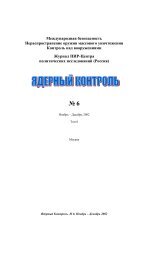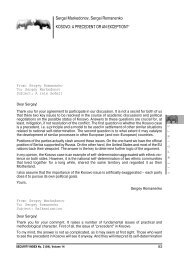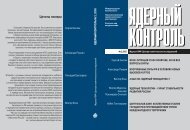Ekaterina Shadrina THE GREAT CASPIAN CAVIAR GAME
Ekaterina Shadrina THE GREAT CASPIAN CAVIAR GAME
Ekaterina Shadrina THE GREAT CASPIAN CAVIAR GAME
Create successful ePaper yourself
Turn your PDF publications into a flip-book with our unique Google optimized e-Paper software.
Despite some degree of progress, the situation in the Caspian remains critical. The absence of<br />
a coordinated policy on the part of the Caspian countries and the international community covering<br />
the sustainable development of marine bioresources, of the Caspian as a whole and sturgeon<br />
in particular, creates a genuine threat to regional security. This challenge can only be<br />
combated through the concerted efforts of the Caspian countries. For this reason, enhancing<br />
regional and international cooperation is a vital step. The development of a unified Caspian policy<br />
for the preservation, restocking, and rational use of sturgeon fish stocks in the long term<br />
could prevent a possible deterioration of relations between the states in the region, ensure<br />
their long-term national interests and, most important, preserve this unique marine resource.<br />
A Russian Tsar’s decree once forbade shouting and singing near sturgeon spawning grounds<br />
to avoid frightening the fish. One would like to believe that the worst times for sturgeon are a<br />
thing of the past, and that even in this modern age that ancient decree will be seen as something<br />
more than an implausible legend.<br />
Notes<br />
1<br />
Konstantin Volkov, “Caviar without Rules,” Itogi, October 2, 2006,<br />
.<br />
2<br />
A publication of the Environment and Security Initiative, created by four international organizations: the<br />
UN Environment Programme (UNEP), the Organisation for Security and Cooperation in Europe (OSCE),<br />
the UN Development Programme (UNDP), and the North Atlantic Treaty Organization (NATO). “UNEP,<br />
UNDV, OSCE and NATO. Environment and Security: Transforming risks into cooperation – Central Asia –<br />
Ferghana / Osh / Khujand area,” 2005, p. 8, .<br />
3<br />
“UNEP, UNDP, OSCE and NATO. Environment and Security: Transforming risks into cooperation –<br />
Central Asia – Ferghana / Osh / Khujand area,” op. cit., p. 9.<br />
4<br />
This work focuses on the five countries bordering the Caspian: Russia, Azerbaijan, Kazakhstan,<br />
Turkmenistan, and Iran.<br />
5<br />
Umirserik Kasenov, “Caspian Oil and International Security,” Central Asia and the Caucasus, No. 11<br />
(1997), .<br />
6<br />
Under a Russian presidential decree, the border services are responsible for protection of sturgeon in<br />
the Caspian and regularly detain poachers not only from local villages, but also from neighboring<br />
Azerbaijan and Kazakhstan.<br />
7<br />
Russia and Iran share a strong position favoring the protection of the unique natural environment of the<br />
Caspian and the prevention of pollution there. In this connection, these countries do not support the projects<br />
for the construction of underwater oil and gas pipelines along the Caspian Sea bed between<br />
Kazakhstan and Azerbaijan and between Turkmenistan and Azerbaijan.<br />
8<br />
Vladimir Ivanov, The Caspian Sea’s Biological Resources (Astrakhan: KaspNIIRKh, 2000), p. 12.<br />
A N A L Y S E S<br />
9<br />
A. Mazhnik, A. Vlasenko, R. Khodorevskaya, G. Zykova, A. Popova, A. Romanov, and S. Bushueva,<br />
“Developing Approaches to Evaluate Sturgeon Stocks and Total Permissable Catches in the Caspian<br />
Sea,” in Fishery Research in the Caspian: Results of 2004 Research (Astrakhan: KaspNIIRKh, 2005), p.<br />
256.<br />
10<br />
Ibid.<br />
11<br />
Vulf Sternin and Ian Dore, 1993; Ivanov, 2000; Protocols of Sessions of the Commission on Aquatic<br />
Bioresources of the Caspian Sea, 1998-2005.<br />
12<br />
Vladimir Ivanov, op. cit., p. 14.<br />
13<br />
It is incorrect to claim that sturgeon caught on the Volga are more contaminated than those caught in<br />
Iranian waters. All sturgeon grow and feed in the Caspian Sea, in the same waters. The degree of contamination<br />
is identical, because fish swimming toward spawning grounds do not feed in rivers.<br />
SECURITY INDEX No. 1 (81), Volume 13<br />
73








